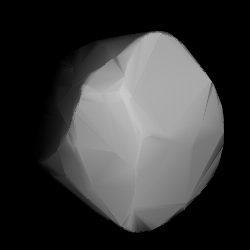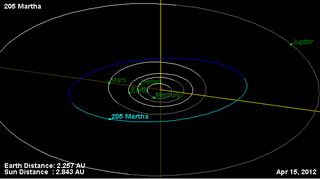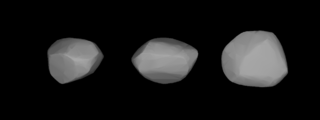Related Research Articles

Bertha is a main-belt asteroid. It was discovered by the French brothers Paul Henry and Prosper Henry on 4 November 1875, but the credit for the discovery was given to Prosper. It is probably named after Berthe Martin-Flammarion, sister of the astronomer Camille Flammarion.

Dejanira is a main belt asteroid that was discovered by Alphonse Borrelly on 1 December 1875, and named after the warlike princess Deianira in Greek mythology. The Dejanira family of asteroids is named after it.

Irma is a fairly large and dark main belt asteroid. It was discovered by the French brothers Paul Henry and Prosper Henry on November 5, 1877. Paul was credited for this discovery. The meaning of the name Irma is unknown.

Menippe is a main belt asteroid. The object has a bright surface and rocky composition. It was discovered by C. H. F. Peters on June 18, 1878, in Clinton, New York, and named after Menippe, one of the daughters of Orion in Greek mythology.

Dynamene is a large dark main-belt asteroid that was discovered by German-American astronomer Christian Heinrich Friedrich Peters on July 27, 1879, in Clinton, New York. The name derives from Dynamene, one of the fifty Nereids in Greek mythology. Based upon its spectrum, 200 Dynamene is classified as a C-type asteroid, indicating that it probably has a primitive composition similar to the carbonaceous chondrite meteorites. The spectra of the asteroid displays evidence of aqueous alteration.

Martha is a large main belt asteroid. It is a dark, primitive carbonaceous C-type asteroid. This object was discovered by Johann Palisa on 13 October 1879, in Pola and was named after Martha, a woman in the New Testament.

Kriemhild is a main belt asteroid that was discovered by Austrian astronomer Johann Palisa on 22 September 1884 in Vienna and was named after Kriemhild, a mythological Germanic princess, by Moriz von Kuffner, a Viennese industrialist and sponsor of astronomy.
Clementina is a large main belt asteroid that was discovered by French astronomer Henri Joseph Anastase Perrotin on 11 October 1885 in Nice, France. The origin of the name is not known.

Ducrosa is a typical Main belt asteroid. It was discovered by Auguste Charlois on 15 March 1895 in Nice.
Bilkis is a minor planet, specifically an asteroid orbiting in the asteroid belt. It was discovered by German astronomer August Kopff in 1906 February and was given the Koran name for the Queen of Sheba. Photometric observations at the Palmer Divide Observatory in Colorado Springs, Colorado in 2006–7 were used to build a light curve for this object. The asteroid displayed a rotation period of 8.5742 ± 0.0005 hours and a brightness variation of 0.40 ± 0.02 in magnitude.

Juvisia is a minor planet, specifically an asteroid orbiting in the asteroid belt that was discovered 27 August 1906 in Heidelberg by German astronomer Max Wolf. It was named after the commune Juvisy-sur-Orge, France, where French astronomer Camille Flammarion had his observatory.
620 Drakonia is a minor planet, specifically an asteroid orbiting in the asteroid belt. It was discovered October 26, 1906, in Taunton, Massachusetts, by American astronomer Joel Hastings Metcalf and given the preliminary designation 1906 WE. It may have been named for Drake University.
687 Tinette is a minor planet, specifically an asteroid orbiting primarily in the asteroid belt. It was discovered by Austrian astronomer Johann Palisa on 16 August 1909 from Vienna and was given the preliminary designation 1909 HG.

708 Raphaela is a minor planet orbiting the Sun.
724 Hapag is a minor planet orbiting the Sun in the asteroid belt that was found by Austrian astronomer Johann Palisa in 1911 and named after the German shipping company Hamburg America Line. It was assigned a provisional name of 1911 NC, then became a lost asteroid until it was rediscovered in 1988 as 1988 VG2 by Tsutomu Hioki and N. Kawasato at Okutama, Japan.
839 Valborg is a mid-sized S-type Eunomian asteroid. Its diameter is about 20 km, its albedo of 0.353 is very high for an asteroid. Its rotation period is 10.366 hours.
829 Academia is a minor planet orbiting the Sun. The asteroid is roughly 44 km in diameter and has a low albedo. Photometric measurements of the asteroid made in 2005 at the Palmer Divide Observatory showed a light curve with a period of 7.891 ± 0.005 hours and a brightness variation of 0.44 ± 0.02 in magnitude.
947 Monterosa is a minor planet orbiting the Sun.
999 Zachia is a main-belt asteroid that was discovered by German astronomer Karl W. Reinmuth in 1923 and named after Hungarian astronomer Franz Xaver von Zach.
39890 Bobstephens (provisional designation 1998 FA3) is a stony asteroid from the middle region of the asteroid belt, approximately 2 kilometers in diameter. The asteroid was discovered on 23 March 1998, by Czech astronomer Petr Pravec at Ondřejov Observatory near Prague in the Czech Republic. It was named for American astronomer Robert Stephens.
References
- 1 2 Yeomans, Donald K., "880 Herba", JPL Small-Body Database Browser, NASA Jet Propulsion Laboratory , retrieved 3 May 2016.
- 1 2 Pilcher, Frederick (April 2012), "Rotation Period Determinations for 31 Euphrosyne, 65 Cybele, 154 Bertha 177 Irma, 200 Dynamene, 724 Hapag, 880 Herba, and 1470 Carla", The Minor Planet Bulletin, 39 (2): 57–60, Bibcode:2012MPBu...39...57P.
- ↑ DMP